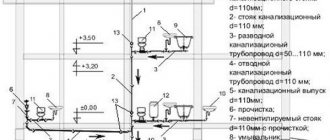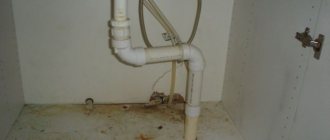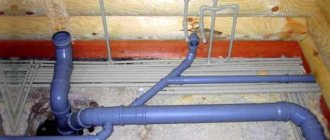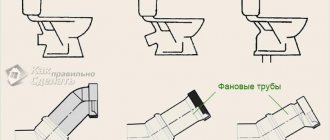Communications in most houses on the secondary real estate market are worn out by more than half. The decision to replace pipes is made for different reasons, but the actions have to be taken in approximately the same way.
Replacing a sewer riser in an apartment raises a number of significant issues. The first thing you should find out is who should carry out the work and at whose expense. Secondly, what and how to do if you have to change the sewer riser yourself.
When should replacement be carried out?
The service life of sewer risers in an apartment building is up to 30 years. This period is determined by the material of their manufacture; previously risers were installed from cast iron.
Modern sewage systems are installed from pipes, for the manufacture of which materials with a longer service life are used. Therefore, their service life is quite long.
Many homes still use outdated cast iron systems whose service life has long expired. During this time, the metal began to deteriorate, and sewer risers and pipes may leak. You should not wait for flooding, which will lead to the need for repair work in several apartments.
Residents of the house have every right to contact the Management Company and raise the issue of replacing sewer risers if their service life has expired. The work must be carried out at the expense of the company, to which residents make contributions under the heading “maintenance and repair of the house.”
Replacement must be carried out as soon as possible under the following circumstances:
- When the collector falls into disrepair.
- When the riser is destroyed due to metal corrosion.
- If an old cast iron pipe exerts strong pressure with its weight on a metal-plastic riser in the apartment below or on the floor above.
Plumbers who service an apartment building always recommend changing the riser on all floors so that it is solid and more reliable.
If cast iron begins to deteriorate in one apartment and leaks appear, after a short time residents of apartments on other floors will encounter the same problems. Therefore, it is worth finding an opportunity to carry out replacement work at the same time. A collective application will only speed up the time it takes to complete the work.
How to properly dismantle the riser?
Before installing a new section of sewer pipe, you need to dismantle the old one.
There are two options:
- the work does not affect floor slabs;
- replacement is carried out with the capture of the area between the floors.
The procedure for dismantling the pipe itself is no different in both cases. The difference lies in the need to open the interfloor ceiling before dismantling the pipe in the second case.
Algorithm for dismantling the sewer riser:
- At a height of 1 m at least from the adjustable fittings, an incision is made on the cast iron pipe with a grinder and the section is removed from the lower socket.
- If the pipe cannot be loosened using a nail puller or chisel, you can try heating it to soften the old sealant.
- The riser is analyzed from top to bottom, from connection to connection.
We recommend that you read: How to install a water tank on a stove pipe in a bathhouse yourself
The opening of floor slabs between floors will need to be agreed upon with the neighbors. Dismantling of ceilings is carried out either with a hammer drill or using a crowbar, chisel and hammer.
Note! Work should be carried out without strong impacts, using rocking, heating, and gentle tapping. Excessive physical impact on a cast iron riser can split it.
Legislation
There are a number of legislative norms that residents of apartments in apartment buildings and owners of privatized and non-privatized housing should definitely know:
- According to Article 290 of the Civil Code of the Russian Federation, sanitary networks inside and outside apartments that serve more than one apartment belong to the residents on the basis of common shared ownership. This applies to risers that are common to several apartments; they are the property of the housing and communal services.
- According to Government Decree No. 491 (08/13/06), the drainage system in a house and apartment is classified as public property.
Both excerpts from legislative documents indicate that the sewerage system and its risers do not belong to the resident’s property, it is common property. Therefore, it must be serviced by housing and communal services institutions - the Management Company, Homeowners' Association, Housing Office.
The fact that the change of collectors is carried out by the service authority is also confirmed by the Rules for the operation of a residential building. They indicate that replacement of the water supply system, cold and hot water supply, and drainage system is included in the current repairs of the house.
Who is the master of the pipes?
An apartment building is a complex object not only from a technical point of view, but also from a legal point of view. The proximity of different interests gives rise to many conflict situations, most of which relate to the management and maintenance of common property.
According to publication 36 of the Housing Code of the Russian Federation, common property in a house with several apartments includes all parts intended to serve more than one room. This is discussed in more detail in the “Rules for the maintenance of common property in a building with several apartments”, approved by Government Decree No. 491 of August 13, 2006. Thus, the common property includes:
- foundation, roof, enclosing load-bearing and non-load-bearing structures of a house with several apartments;
- premises that are not parts of apartments and non-residential premises, intended to serve more than one room in this building;
- technical communications and equipment (electrical, sanitary, etc.) outside the boundaries and in the middle of the building, serving more than one room;
- a plot of land with landscaping and improvement components;
- other objects intended for the maintenance, operation and arrangement of this house located on this land plot.
Technical communications and equipment are recognized as the common property of the owners if there is a single, but most important feature - maintenance of more than one premises. Riser pipes, branches from them, communal meters, shut-off and control valves, sewer outlets, plugs, etc. - all this is in the common ownership of the residents of a building with several apartments.
Now let's imagine the situation. You live in a house with several apartments on the top floor. The neighbors on the floor below had a burst cold water supply - residents living even lower are flooded. There are no difficulties in your apartment, everything is dry and in good order. However, the residents of the apartment from which the leak is occurring are asking for repairs to be made to the common property, which means replacement of the plumbing equipment in your home. Is this legal?
At first glance, yes, completely. After all, as we have already found out, risers are common property, which means, according to existing legislation, residents bear the burden of maintaining it in proportion to their own shares in the right of common ownership of this property. In this case, it does not matter what form of management is used in relation to this house with several apartments (management organization, HOA, housing cooperative, etc.) - the owners make contributions for repairs under any circumstances.
There are several types of repairs: current and major. The first is one in which work is carried out as planned with the aim of replacing or restoring individual parts and engineering systems of the house (for example, replacing part of a rusted pipe in the basement). The second involves the replacement or restoration of individual parts or entire structures and engineering equipment of a building due to their physical wear and tear or destruction, and even if modernization is required. Overhaul can be aimed at replacing one component of the engineering system, or several - due to this, it is divided into comprehensive and selective. Replacing risers mainly refers to selective overhauls.
Current repairs are carried out at the expense of management organizations, while capital repairs are paid from the owners’ pockets. Therefore, in order to do it, you need to convene a general meeting of residents, at which a decision on repairs is made, its scope and estimated price are established. Therefore, in the above example, the conditions of the residents of an apartment with a broken riser are legitimate, provided that a general meeting of the residents of this building was held, and 2/3 of them agreed to make major repairs to replace the risers.
However, approaching this curiosity in more detail, let's remember the main criterion for classifying engineering buildings as common property - they must use more than one room. In other words, the cold water supply riser is considered common property, but the pipes that go from it are located in an individual apartment and serve only that apartment - not. This is already the property of the residents of this apartment. Repair or replacement of pipes in the apartment is carried out at the expense of the owner. Similarly, no one has the right to demand the replacement of pipes and other plumbing equipment, if they are in working order and do not belong to the common property in your apartment.
What to do
The management company does not always show great interest in the condition of the technical equipment of the house. How to force the riser to be changed in this case?
If a drainage pipe, common to many apartments, becomes unusable due to corrosion of cast iron, if leaks appear, there is no need to wait for an emergency, you should contact the Criminal Code, draw up an application for replacement, a sample of which should be in the reception area.
ATTENTION! It is advisable that such an application be from several apartments at once, but it can also be submitted individually.
The application must be registered and accepted for consideration. Representatives of the management company must notify the residents in advance about the time of work, as well as the entire house that repair work will take place in it, and the water will be turned off for a while.
Work order
Installation of a new riser is carried out in a certain sequence. In order for this process to proceed without complications, it is necessary to provide for a number of points.
Precautionary measures
Carrying out plumbing work involves the use of electric tools, contact with toxic fumes, and sharp and heavy objects.
The following safety precautions must be observed:
- ensure good ventilation of the bathroom;
- use an insulating or filtering gas mask;
- perform work wearing protective gloves, goggles and an assembly helmet;
- use proper electric tools.
You should decide in advance how to secure the riser from above so that it does not fall along with the tee onto the repairman during the repair process.
How to prepare for the replacement process
In order for the installation of a new riser to be completed quickly and efficiently, it is necessary to carefully plan this work. You should check in advance the possibility of dismantling the toilet, draw up a diagram of the location of the tee sockets, inserts, fittings and adapters.
Everything should be at hand so as not to interrupt work to go to the store for missing items.
Devices tools and materials
In order to change the riser, the following tools and materials are needed:
- perforator;
- hammer;
- Bulgarian;
- oil level;
- screwdrivers;
- putty knife;
- chisel;
- pipes with a diameter of 50 mm and 100 mm;
- sealing agents;
- clamps;
- plastic dowels and screws for them.
It is advisable to prepare garbage bags and boxes, rags and buckets to collect dirt and water.
If housing and communal services refuse
When drawing up an application, you must immediately indicate references to legislative acts, according to which the maintenance and repair of this part of the utility systems is carried out by the housing office or the homeowners' association, management company.
Most often, the refusal is due to the fault of the residents themselves. For example, they independently carry out replacements, damage pipes, rearrange the heated towel rail and disrupt the operation of the entire heating system.
In this case, the owner of the apartment must reimburse the costs of repairs. According to the rules, the duty of the Housing Office is to replace the old cast-iron riser with a plastic one. If the pipes were damaged by the residents, they also pay for the repairs.
But the refusal on the part of the housing and communal services institution may be unfounded. In such a case, the applicant or applicants must request that the refusal be in writing. With such a document, you can first contact the manager of the management company or HOA, then Rospotrebnadzor, the Housing Inspectorate. If there is no result from such actions, a statement of claim should be filed in court.
ATTENTION! The court is the final authority; it will certainly require evidence of attempts to resolve the problem pre-trial.
Complaint about poor quality replacement of risers in an apartment building
If the emergency riser is replaced poorly, the apartment owner has the right to file a complaint against the organization responsible for this matter. The complaint is submitted in writing to the State Housing Inspectorate of a specific region of Russia. It indicates the name and address of the owner where the emergency water riser is located.
The complaint consists of a statement and a request. The application must refer to Art. 161 of the Housing Code of the Russian Federation “General requirements for the management of an apartment building” and indicate that the repair work did not eliminate the emergency situation. The petition contains the applicant’s request to oblige the management company to correct the problems in accordance with the standards.
It would not be amiss to attach to the complaint photographic materials proving poor quality work, as well as an act drawn up between the tenant and the management company.
Does the management company have the right to demand payment?
Such actions of the Management Company violate the law. The apartment owner does not have to pay for labor and materials for the following reasons:
- Sewer risers are common property and are maintained, repaired, and replaced at the expense of the service organization. If we are not talking about replacing a pipe due to the fault of the residents themselves, who damaged it as a result of carrying out the work independently.
- Apartment owners already pay for repairs by transferring monthly funds under the “house maintenance” column. The amount that accumulates through such transfers should pay for ongoing repairs.
When plumbers still insist on payment, you should complain about them first to your boss, then to Rospotrebnadzor or the prosecutor's office.
How to make an application
There is no strictly established template for drawing up such a statement. Each management company or housing office can develop its own version of the document. But there are general rules that are the same for all housing and communal services institutions:
- First, the name of the management company and the information of the manager (full name) are indicated.
- Then you need to write about the absence of debt on utility bills, confirming with a copy of the receipt.
- Next is a request to replace the riser.
- The application is signed by the owner of the apartment or the owners of all apartments along the riser.
The document is drawn up in at least two copies, one of which must be in the hands of the residents. If the management company does not carry out replacement work within the required time frame, the registered application will become the basis for contacting the regulatory authorities.
Replacing pipes when an apartment is flooded
Sometimes it is necessary to change the riser in emergency conditions, in case of severe sewerage leakage and flooding of the apartment (apartments). What to do in case of an accident? The apartment owner contacts the emergency service, its employees must arrive on site and draw up an inspection report.
IMPORTANT! This act indicates whose fault the leak occurred.
The fault of the Management Company is confirmed if the leak occurred due to rotten, corroded pipes. By law, the service company must monitor the condition of the pipes.
When accepting a house for service, it is necessary to establish what year it was built and when major repairs were carried out. It is not difficult to assume that wastewater drains may already require replacement due to their expired service life.
In the case where the apartment owner himself changed the riser and pipes, did it incorrectly and caused flooding, the blame for what happened lies with him.
Typically, such an act is needed when the insured apartment has been damaged and insurers need to decide who will compensate for the damage.
When is it time to change the riser?
Partial replacement of a section of the communal sewer system in an apartment is carried out when the following circumstances occur :
- the riser has completely or partially failed;
- the owner of the premises or the tenant has decided to carry out a major overhaul of the water supply and sanitation system in his living space;
- replacement of the riser is included in the planned general building overhaul;
- dismantling part of the pipe when clogged .
Timely replacement of the riser will allow you to avoid the unpleasant consequences of its leakage in the event of failure.
If the owner of the apartment did not notify the management company about the emergency condition of the pipe, managers can decline responsibility for causing material damage.
Carrying out the procedure yourself
- Interfering with the drainage system (this also applies to water supply and heating) is a responsible and not safe step.
- Replacement of risers can only be carried out with the permission of the management company, when other residents are notified about the work.
- You cannot change the location of this pipe or its configuration.
- Even if it is customary to do the replacement yourself, you still need to invite a qualified plumber to do the work.
- If the riser is covered with plasterboard, an inspection hatch should be left to monitor its condition.
- The telephone number of the control room of the Management Company and the emergency service should always be at hand in the apartment.
Regulations
Russian legislation has a clear procedure for replacing risers and other parts of the sewer system.
The procedure is regulated by the following documents :
- GOST R 56534-2015;
- “Rules for the maintenance of common property in apartment buildings” , approved by Decree of the Government of the Russian Federation No. 491 of August 13, 2006;
- “Rules and standards for the technical operation of housing stock” , approved by Order of the State Construction Committee of the Russian Federation No. 17-139 of December 25, 1998;
- Methodological manual MDK 2-04-2004.
Read in this article who is responsible for replacing a leaking heating battery.











